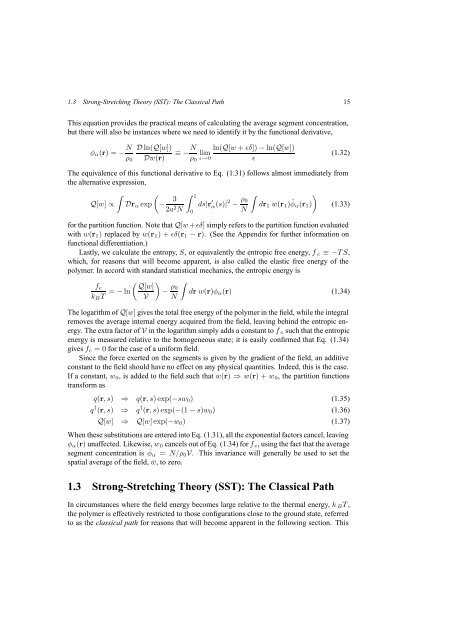Self-Consistent Field Theory and Its Applications by M. W. Matsen
Self-Consistent Field Theory and Its Applications by M. W. Matsen
Self-Consistent Field Theory and Its Applications by M. W. Matsen
You also want an ePaper? Increase the reach of your titles
YUMPU automatically turns print PDFs into web optimized ePapers that Google loves.
1.3 Strong-Stretching <strong>Theory</strong> (SST): The Classical Path 15<br />
This equation provides the practical means of calculating the average segment concentration,<br />
but there will also be instances where we need to identify it <strong>by</strong> the functional derivative,<br />
φ α (r) =− N ρ 0<br />
D ln(Q[w])<br />
Dw(r)<br />
≡− N ρ 0<br />
lim<br />
ɛ→0<br />
ln(Q[w + ɛδ]) − ln(Q[w])<br />
ɛ<br />
(1.32)<br />
The equivalence of this functional derivative to Eq. (1.31) follows almost immediately from<br />
the alternative expression,<br />
∫<br />
Q[w] ∝<br />
(<br />
Dr α exp − 3<br />
2a 2 N<br />
∫ 1<br />
0<br />
ds|r ′ α(s)| 2 − ρ ∫<br />
0<br />
N<br />
)<br />
dr 1 w(r 1 ) ˆφ α (r 1 )<br />
(1.33)<br />
for the partition function. Note that Q[w + ɛδ] simply refers to the partition function evaluated<br />
with w(r 1 ) replaced <strong>by</strong> w(r 1 )+ɛδ(r 1 − r). (See the Appendix for further information on<br />
functional differentiation.)<br />
Lastly, we calculate the entropy, S, or equivalently the entropic free energy, f e ≡−TS,<br />
which, for reasons that will become apparent, is also called the elastic free energy of the<br />
polymer. In accord with st<strong>and</strong>ard statistical mechanics, the entropic energy is<br />
( )<br />
f e Q[w]<br />
k B T = − ln − ρ ∫<br />
0<br />
dr w(r)φ α (r) (1.34)<br />
V N<br />
The logarithm of Q[w] gives the total free energy of the polymer in the field, while the integral<br />
removes the average internal energy acquired from the field, leaving behind the entropic energy.<br />
The extra factor of V in the logarithm simply adds a constant to f e such that the entropic<br />
energy is measured relative to the homogeneous state; it is easily confirmed that Eq. (1.34)<br />
gives f e =0for the case of a uniform field.<br />
Since the force exerted on the segments is given <strong>by</strong> the gradient of the field, an additive<br />
constant to the field should have no effect on any physical quantities. Indeed, this is the case.<br />
If a constant, w 0 , is added to the field such that w(r) ⇒ w(r) +w 0 , the partition functions<br />
transform as<br />
q(r,s) ⇒ q(r,s)exp(−sw 0 ) (1.35)<br />
q † (r,s) ⇒ q † (r,s)exp(−(1 − s)w 0 ) (1.36)<br />
Q[w] ⇒ Q[w]exp(−w 0 ) (1.37)<br />
When these substitutions are entered into Eq. (1.31), all the exponential factors cancel, leaving<br />
φ α (r) unaffected. Likewise, w 0 cancels out of Eq. (1.34) for f e , using the fact that the average<br />
segment concentration is ¯φ α = N/ρ 0 V. This invariance will generally be used to set the<br />
spatial average of the field, ¯w, to zero.<br />
1.3 Strong-Stretching <strong>Theory</strong> (SST): The Classical Path<br />
In circumstances where the field energy becomes large relative to the thermal energy, k B T ,<br />
the polymer is effectively restricted to those configurations close to the ground state, referred<br />
to as the classical path for reasons that will become apparent in the following section. This
















